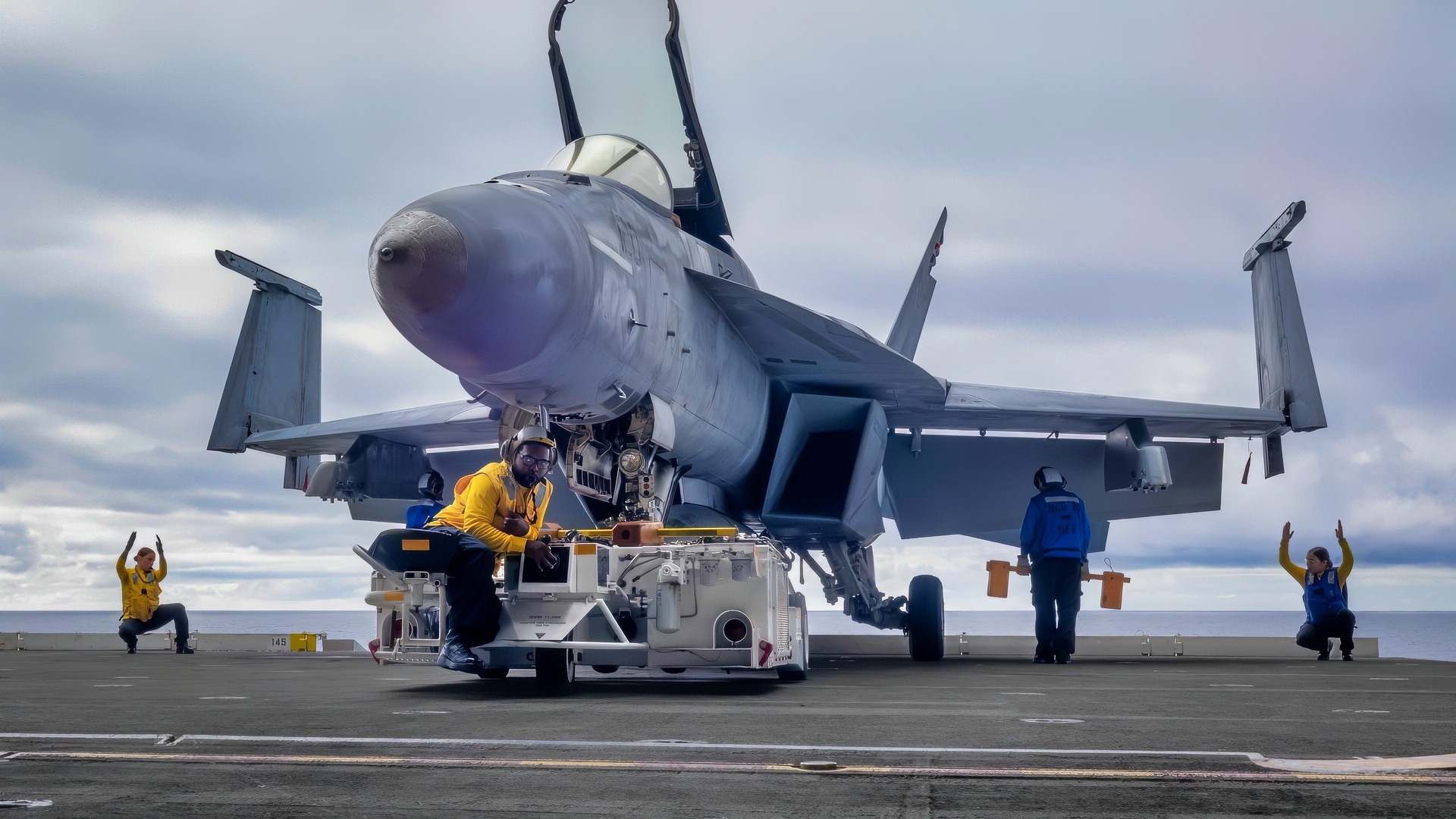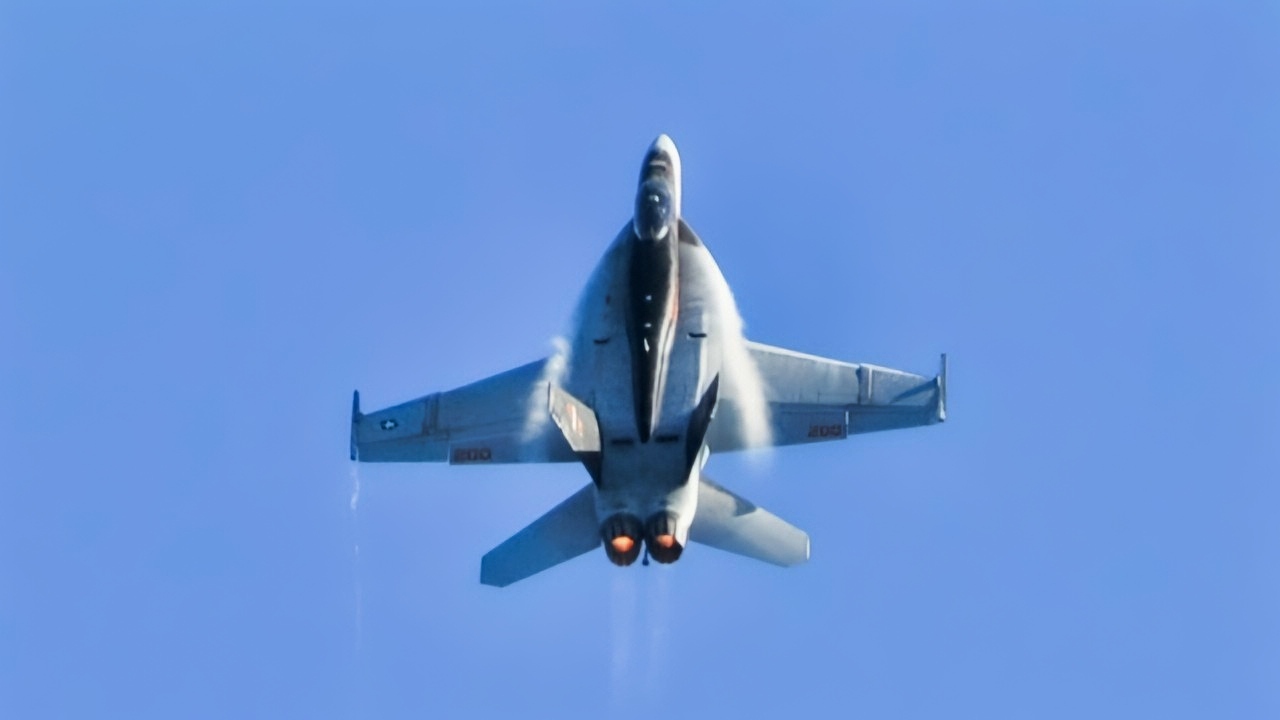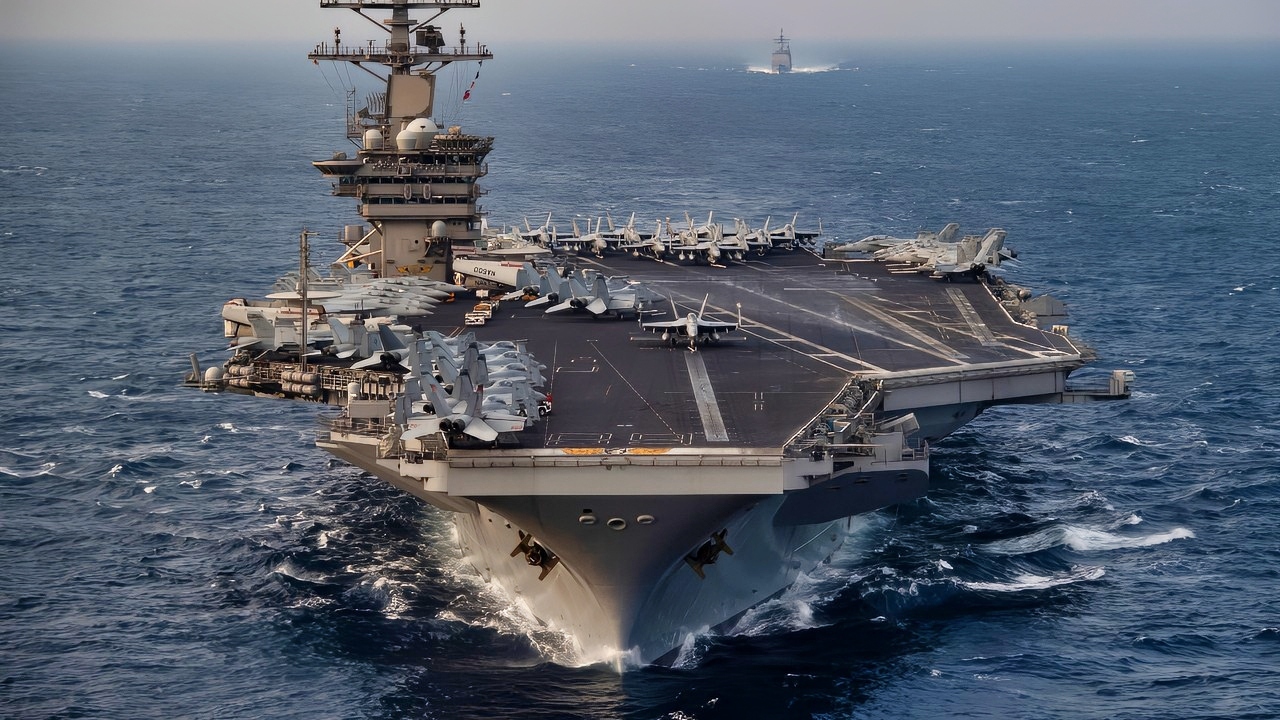Key Points and Summary – USS Nimitz (CVN-68), first of the Nimitz-class supercarriers, is concluding a 50-year career that spanned the Cold War, Eagle Claw, Southern Watch, and post-9/11 wars in Afghanistan and Iraq.
-Commissioned in 1975 and repeatedly upgraded through RCOHs, the 1,092-foot, nuclear-powered carrier launched 60–70-aircraft air wings and sustained long deployments across the globe, from NATO exercises to South China Sea FONOPs and disaster relief.

ATLANTIC OCEAN (Aug. 13, 2025) Sailors transport an F/A-18E Super Hornet attached to the “Gladiators” of Strike Fighter Squadron (VFA) 106 onto an aircraft elevator aboard the Nimitz-class aircraft carrier USS George H.W. Bush (CVN 77). George H.W. Bush is underway conducting carrier qualifications and routine operations in the Atlantic Ocean. (U.S. Navy photo by Mass Communication Specialist Seaman Apprentice Kayleigh Tucker)
-With decommissioning planned after her final deployment—expected by spring 2026—Nimitz cedes the spotlight to the Ford-class, whose EMALS, advanced sensors, and lower manning reflect the next chapter in U.S. carrier power projection.
USS Nimitz Will Be Retired Soon: Aircraft Carrier Mistake?
The USS Nimitz (CVN-68) was the flagship of the Nimitz-class aircraft carriers. These carriers were some of the largest and most formidable vessels in U.S. Naval history. First entering service in the 70s, the USS Nimitz has had a long and eventful service life, taking part in missions all across the globe.
However, as the ship is now in its 50th year of active service, the time has come to retire the venerable carrier. Her retirement is expected to take place when she returns to her homeport in Norfolk, Virginia, where she will be fully decommissioned.
Design and Development
The concept for the Nimitz-class carriers was conceived during the Cold War, a period of intense rivalry between the U.S. and the Soviet Union.
The U.S. Navy recognized the need for a new generation of aircraft carriers that could operate longer, carry more aircraft, and withstand the demands of modern warfare. Construction of the USS Nimitz began in 1968 at Newport News Shipbuilding in Virginia, a shipyard renowned for its expertise in building large naval vessels. She was launched in 1972 and officially commissioned into service on May 3, 1975. At the time of her commissioning, she was the largest warship ever constructed, measuring 1,092 feet in length and displacing over 100,000 tons.

A U.S. Navy F/A-18E Super Hornet aircraft assigned to Strike Fighter Squadron (VFA) 147 performs maneuvers above the aircraft carrier USS Nimitz (CVN 68) during the departure of Carrier Air Wing (CVW) 11 Dec. 10, 2013, in the Pacific Ocean. CVW-11 fixed wing aircraft flew off the Nimitz to return home after being deployed to the U.S. 5th, 6th and 7th Fleet areas of responsibility. (U.S. Navy photo by Mass Communication Specialist Seaman Apprentice Kelly M. Agee/Released)
Powered by two nuclear reactors, the USS Nimitz can operate for over 20 years without refueling, a capability that significantly reduces logistical constraints and enables extended deployments worldwide.
This innovation not only enhances operational endurance but also underscores the strategic flexibility of the U.S. Navy.
The ship’s flight deck spans more than four and a half acres, providing ample space for simultaneous aircraft launches and recoveries.
Her air wing typically consists of 60 to 70 aircraft, including fighter jets such as the F/A-18 Hornet and Super Hornet, electronic warfare planes like the EA-18G Growler, and airborne early warning aircraft like the E-2 Hawkeye.
The carrier’s crew includes approximately 5,000 personnel, encompassing both the ship’s company and the air wing.
While the USS Nimitz is primarily an aircraft platform, she is also equipped with defensive weapons systems, including the Phalanx Close-In Weapon System (CIWS), Sea Sparrow missiles, and Rolling Airframe Missiles (RAM), which provide protection against incoming threats.

Amphibious assault ship USS Makin Island (LHD 8) and aircraft carrier USS Nimitz (CVN 68) perform expeditionary strike force (ESF) operations, Feb. 15, 2023 in the South China Sea. Nimitz Carrier Strike Group (NIMCSG) and amphibious assault ship USS Makin Island (LHD 8) with embarked 13th Marine Expeditionary Unit are conducting joint ESF operations, representing unique high-end war fighting capabilities, maritime superiority, and power projection, demonstrating the U.S. commitment to our allies and partners in the Indo-Pacific region. (U.S. Navy photo by Mass Communication Specialist 3rd Class Kendra Helmbrecht)
Operational History
Throughout her operational history, the USS Nimitz has played a pivotal role in numerous military operations, humanitarian missions, and strategic deployments.
During the Cold War, she was frequently deployed to the Mediterranean and Indian Ocean, serving as a visible deterrent to Soviet naval forces. In 1980, she was involved in Operation Eagle Claw, the ill-fated attempt to rescue American hostages in Iran. Although the mission was unsuccessful, it highlighted the importance of aircraft carriers in rapid-response scenarios.
In the 1990s, the USS Nimitz supported Operation Southern Watch, enforcing no-fly zones over Iraq following the Gulf War. She also participated in operations in the Balkans and conducted joint exercises with allied navies, reinforcing international partnerships and demonstrating the versatility of carrier strike groups.
The Nimitz Post 9/11
Following the September 11 attacks in 2001, the USS Nimitz became a key asset in the Global War on Terror. She supported Operation Enduring Freedom in Afghanistan and Operation Iraqi Freedom, launching airstrikes and providing logistical support to ground forces.
Her ability to remain on station for extended periods made her an invaluable tool in sustained combat operations, and her presence in volatile regions often served as a stabilizing force.
Despite her age, the USS Nimitz has undergone multiple Refueling and Complex Overhauls (RCOH), which have modernized her systems and extended her service life.
These overhauls included upgrades to her radar, communications, and weapons systems, ensuring that she remains capable of meeting contemporary threats.
In recent years, she has continued to participate in freedom of navigation operations in the South China Sea, joint exercises with NATO allies, and humanitarian missions such as disaster relief in Southeast Asia.
Legacy and Retirement
The USS Nimitz and the Nimitz-class in general laid the foundation for the next generation of carriers, including the Gerald R. Ford-class, which builds upon the Nimitz’s legacy with even more advanced systems and capabilities.
The Ford-class carriers feature electromagnetic aircraft launch systems (EMALS), improved radar and communications, and reduced crew requirements, reflecting the evolution of carrier design in the 21st century.
As of 2025, the USS Nimitz remains in active service, though plans for her decommissioning are underway. Nimitz-class carriers typically have a lifespan of around 50 years before retirement. The USS Nimitz was commissioned in May of 1975, meaning she has already exceeded her 50-year limit.
As of the time of writing, the Nimitz is currently on her last deployment. She is expected to retire in the Spring of 2026, making way for newer carriers like the USS Gerald R. Ford (CVN-78) and USS John F. Kennedy (CVN-79).
Her decommissioning will mark the end of an era, but her legacy will endure through the ships and sailors she has inspired.
About the Author: Isaac Seitz
Isaac Seitz, a Defense Columnist, graduated from Patrick Henry College’s Strategic Intelligence and National Security program. He has also studied Russian at Middlebury Language Schools and has worked as an intelligence Analyst in the private sector.
This has been updated to fix a factual mistake.
More Military
The F-35A Stealth Fighter Is Also a Stealth Bomber
Mach 2.65 F-111 ‘Aardvark’ Strike Fighter Has a Message for the U.S. Military
Russia’s MiG-29 Fulcrum Fighter Has a Message for NATO
The X-40A Space Plane Has a Message for the U.S. Military
The Mach 6.7 X-15 Space Plane Has a Message for the U.S. Air Force











Mark Klein
September 27, 2025 at 11:08 am
You really need to do more research before you write an article like this. You mention that the Nimitz class has a similar nuclear power plant to the Kitty Hawk class, but that class of ships was not nuclear powered,but the last oil fired carriers to be built in the U.S. When you get a detail like that wrong, it seems like your research is a bit suspect, and I wouldn’t ever bother finishing the article. Most of the info on this website is clickbait anyway, with very little new information being presented.
Vincent Nguyen
September 28, 2025 at 11:16 pm
With China looms in horizon as the most challenging foe since the WW2, we should mothball all the Nimitz class should next world war occur. Scrapping them in my humble opinion is tantamount to commit suicide.
Mark Powell
September 30, 2025 at 4:26 pm
Article mentioned numerous RCOH this ship has only had one of them. Others were just overhaul
Ghost_Tomahawk
September 30, 2025 at 5:15 pm
Id keep these around just in case.
Next question. Why are we naming the next class Ford Class? It’s not like he was a decorated skipper of a carrier at any time. He was just another officer on a light carrier until he left in 46.
These decks will lose their bad luck when they drop their lame duck namesake.